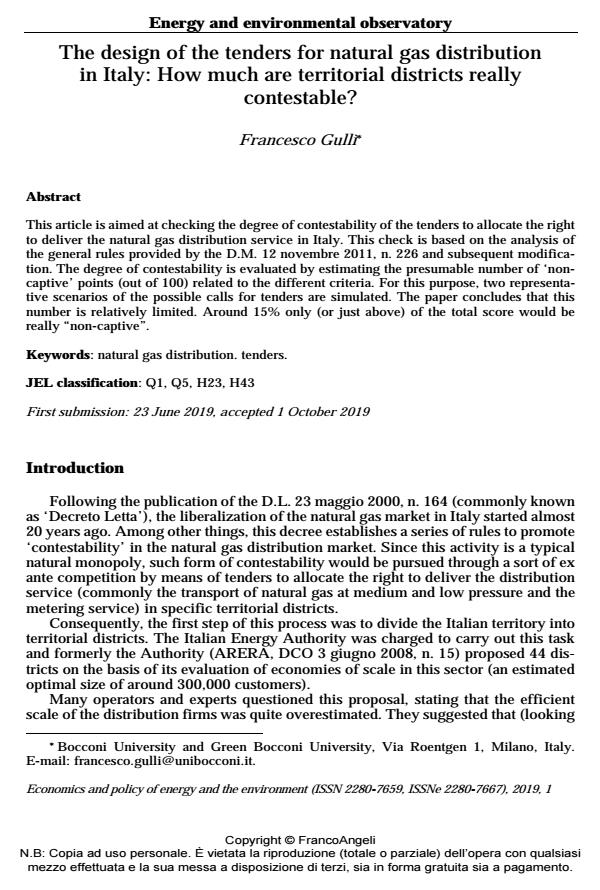The design of the tenders for natural gas distribution in Italy: How much are territorial districts really contestable?
Journal title ECONOMICS AND POLICY OF ENERGY AND THE ENVIRONMENT
Author/s Francesco Gullì
Publishing Year 2019 Issue 2019/1 Language English
Pages 25 P. 5-29 File size 195 KB
DOI 10.3280/EFE2019-001001
DOI is like a bar code for intellectual property: to have more infomation
click here
Below, you can see the article first page
If you want to buy this article in PDF format, you can do it, following the instructions to buy download credits

FrancoAngeli is member of Publishers International Linking Association, Inc (PILA), a not-for-profit association which run the CrossRef service enabling links to and from online scholarly content.
This article is aimed at checking the degree of contestability of the tenders to allocate the right to deliver the natural gas distribution service in Italy. This check is based on the analysis of the general rules provided by the D.M. 12 novembre 2011, n. 226 and subsequent modification. The degree of contestability is evaluated by estimating the presumable number of ‘noncaptive’ points (out of 100) related to the different criteria. For this purpose, two representative scenarios of the possible calls for tenders are simulated. The paper concludes that this number is relatively limited. Around 15% only (or just above) of the total score would be really "non-captive".
Keywords: Natural gas distribution. tenders.
Jel codes: Q1, Q5, H23, H43
- ARERA, DCO 15/08, riguardante “Ipotesi per la formulazione di proposte in materia di individuazione di bacini ottimali di utenza”.
- ARERA, 24 luglio 2014, n. 367/2014/R/GAS, in materia di “Regolazione dei servizi di distribuzione e misura del gas per il periodo di regolazione 2014-2019 per le gestioni d’ambito e altre disposizioni in materia tariffaria”.
- D.Lgs. 23 maggio 2000, n. 164, in materia di “Attuazione della Direttiva n. 98/30/CE recante norme comuni per il mercato interno del gas naturale”.
- D.M. 19 gennaio 2011, n. 74, in materia di “Determinazione degli ambiti territoriali nel settore della distribuzione del gas naturale”.
- D.M. 12 novembre 2011, n. 226, in materia di “Regolamento per i criteri di gara e per la valutazione dell’offerta per l’affidamento del servizio della distribuzione di gas naturale”.
- D.M. 22 maggio 2014, n. 353, in materia di “Approvazione delle line guida su criteri e modalità applicative per la valutazione del valore di rimborso degli impianti di distribuzione del gas naturale”.
- D.M. 20 maggio 2015, n. 106, in materia di “Regolamento recante modifica al decreto 12 novembre 2011, n. 226”.
- D.P.R. 5 ottobre 2010, n. 207, in materia di “Codice di contratti pubblici relative a lavori, servizi e forniture in attuazione delle direttive 2004/17/CE e 2004/18/CE, Allegato G (art. 120)”.
- Gullì F. (2009). Economie di scala e dimensione ottimale nella distribuzione del gas: una meta-analisi. Economics and policy of energy and the environment, 3.
- Gullì F. (2014). “Competition for the field” and pricing regulation: the case of the natural gas distribution in Italy, Economics and policy of energy and the environment, 2: 21-42.
- Gullì F. (2017). Investments projects in natural gas distribution in Italy: a model of social cost-benefit analysis, Economics and policy of energy and the environment, 3: 5-25.
- Ministero dello Sviluppo Economico (MISE) 7 aprile 2014, Linee guida su criteri e modalità applicative per la valutazione del valore di rimborso degli impianti di distribuzione del gas naturale.
- R.D. 15 ottobre 1925, n. 2578, in materia di “Approvazione del testo unico della legge sull’assunzione diretta dei pubblici servizi da parte dei comuni e delle provincie”.
Francesco Gullì, The design of the tenders for natural gas distribution in Italy: How much are territorial districts really contestable? in "ECONOMICS AND POLICY OF ENERGY AND THE ENVIRONMENT" 1/2019, pp 5-29, DOI: 10.3280/EFE2019-001001